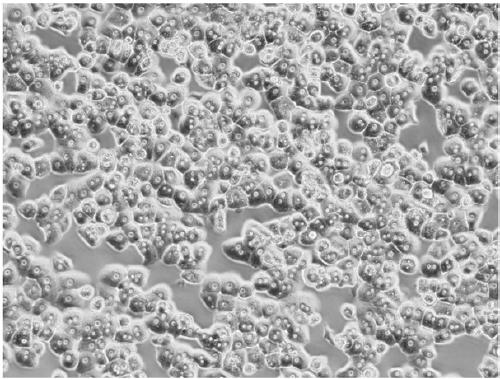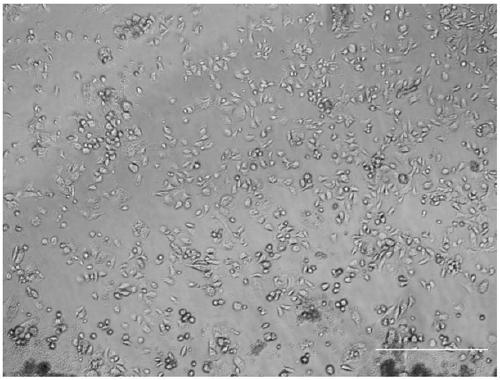Method for extracting, separating and culturing consubstantial xenogeneic liver primary cell
A primary cell and heterogeneous technology, applied in the field of cell culture, can solve the problems of difficult separation and culture of various non-parenchymal cells, low extraction activity, and low purity, and achieve low cost, reduced cell damage, and high purity.
- Summary
- Abstract
- Description
- Claims
- Application Information
AI Technical Summary
Problems solved by technology
Method used
Image
Examples
Embodiment 1
[0022] After anesthetizing 150g male SD rats, open the abdomen, use a 0.7×19mm 24G indwelling needle to intubate the hepatic portal vein, and then inject 10mM EGTA and 20mM HEPES without Ca 2+ , Mg 2+ The HBSS perfusate was perfused at a constant temperature of 37°C for 10 min through the hepatic portal vein, and the perfusion rate was controlled at 10 mL / min, and no air bubbles should be generated during the perfusion process; replace the perfusate with a concentration of 50 mg / L CaCl 2 , 50mM HEPES, 100mg / L type Ⅳ collagenase, 100U / mL penicillin, 100U / mL streptomycin, DMEM-high glucose digestion solution was perfused at a constant temperature of 37°C for 10min through the hepatic portal vein, and the perfusion rate was controlled at 10mL / min; The digested liver was carefully taken out and placed in a vessel containing DMEM-high sugar with a concentration of 5 μM dexamethasone and 10% FBS, and the capsule on the surface of the liver was carefully scratched with tweezers, blun...
Embodiment 2
[0024] After anesthetizing 100g male Wistar rats, open the abdomen, use a 0.7×19mm 24G indwelling needle to intubate the hepatic portal vein, and then inject D-Hanks perfusate with a concentration of 2mM EGTA and 10mM HEPES through the hepatic portal vein at a constant temperature of 37°C in situ Perfuse for 15 minutes, the perfusion speed is controlled at 15mL / min, and no air bubbles should be generated during the perfusion process; replace the perfusate with a concentration of 50mg / L CaCl 2 , 50mM HEPES, 100mg / L type Ⅱ collagenase, 100U / mL penicillin, 100U / mL streptomycin, DMEM-high glucose digestion solution was in situ perfused at a constant temperature of 37°C for 10min through the hepatic portal vein, and the perfusion rate was controlled at 10mL / min; The digested liver was carefully taken out and placed in a vessel containing DMEM-high sugar with a concentration of 5 μM dexamethasone and 10% FBS, and the capsule on the surface of the liver was carefully scratched with tw...
Embodiment 3
[0026] After anesthetizing 20g male C3H / He mice, open the abdomen, use a 0.7×19mm 24G indwelling needle to intubate the hepatic portal vein, and then inject D-Hanks perfusate with a concentration of 5mM EGTA and 20mM HEPES through the hepatic portal vein in situ37 ℃ constant temperature perfusion for 10min, the perfusion rate is controlled at 5mL / min, and no air bubbles should be generated during the perfusion process; replace the perfusate with a concentration of 50mg / L CaCl 2 , 50mM HEPES, 100mg / L type Ⅱ collagenase, 100U / mL penicillin, 100U / mL streptomycin, DMEM-high glucose digestion solution was in situ perfused at a constant temperature of 37°C for 10min through the hepatic portal vein, and the perfusion rate was controlled at 10mL / min; The digested liver was carefully taken out and placed in a vessel containing DMEM-high sugar with a concentration of 5 μM dexamethasone and 10% FBS, and the capsule on the surface of the liver was carefully scratched with tweezers, bluntly...
PUM
 Login to View More
Login to View More Abstract
Description
Claims
Application Information
 Login to View More
Login to View More - R&D
- Intellectual Property
- Life Sciences
- Materials
- Tech Scout
- Unparalleled Data Quality
- Higher Quality Content
- 60% Fewer Hallucinations
Browse by: Latest US Patents, China's latest patents, Technical Efficacy Thesaurus, Application Domain, Technology Topic, Popular Technical Reports.
© 2025 PatSnap. All rights reserved.Legal|Privacy policy|Modern Slavery Act Transparency Statement|Sitemap|About US| Contact US: help@patsnap.com



